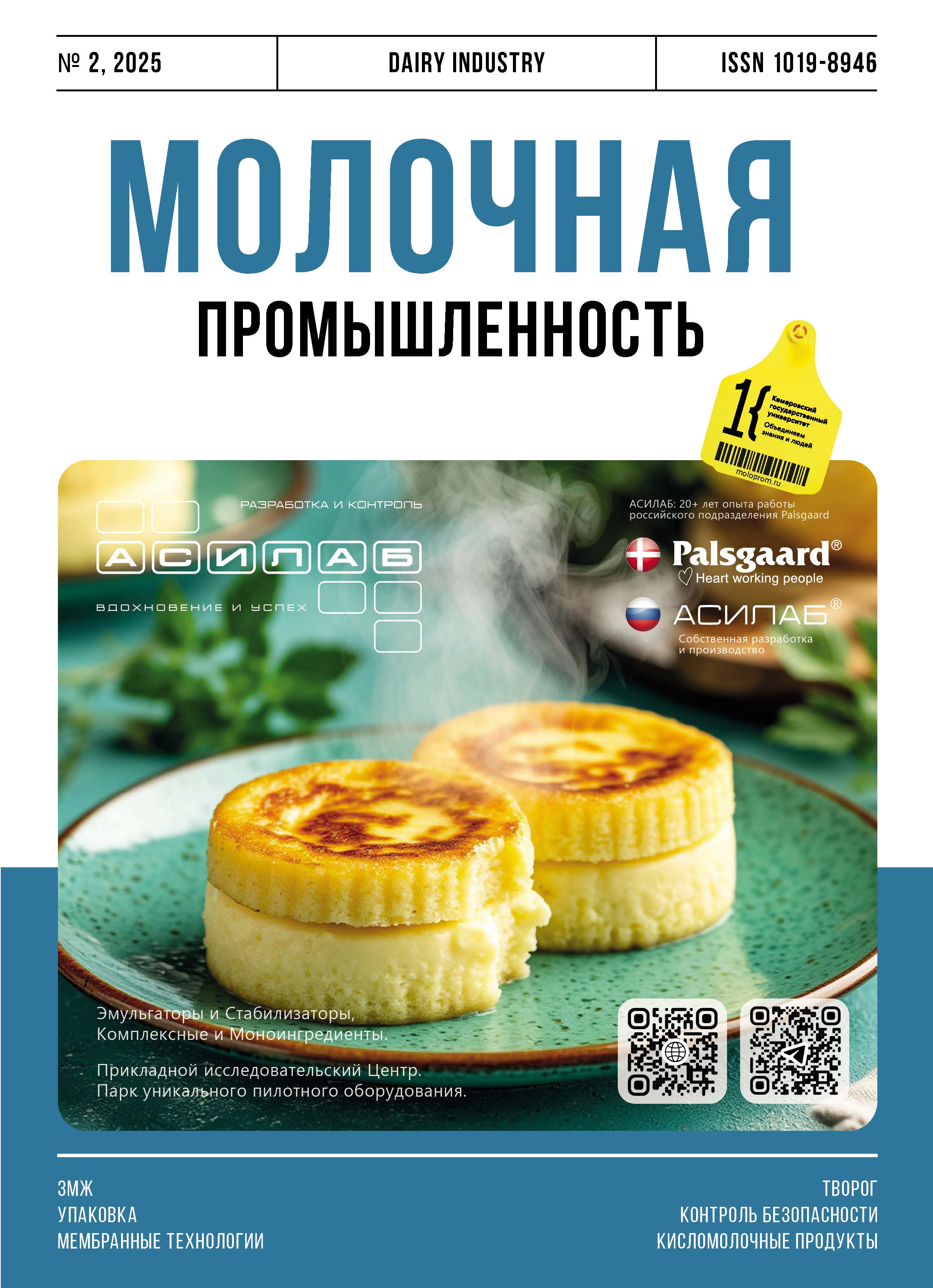Synergy University (Associate Professor)
Moscow, Moscow, Russian Federation
Regional industrial clusters increase competitiveness and efficiency of the entire industry. This article describes the trends and dynamics of the dairy industry in Russia’s regions in 2017–2022. An autocorrelation analysis based on Moran’s I was performed to identify potential clusters with good development prospects. Dairy production was distributed relatively evenly across the country, with a denser concentration in the southern and central regions with their favorable climatic conditions and large sales markets. Moran’s I spatial scatter diagrams revealed that the number of dairy employees peaked in 2017 (0.338) and dropped in 2021 (0.300). The indicator declined twice during the period: in 2018 (to 0.316) and in 2021. As for the production volume, the distribution was more compact. The cluster analysis made it possible to study the developmental trends, competitiveness, spatial distribution patterns, and prospects of new industrial clusters. The results may be used to design new strategies for regional cluster development and support, as well as to identify regions with poor dairy development and take support measures.
dairy clusters, dairy industry, cluster policy, Moran’s I
1. Lisicyn, A. B. Ot prodovol'stvennoy bezopasnosti k bezopasnosti i kachestvu prodovol'stviya / A. B. Lisicyn, I. M. Chernuha, O. I. Lunina // Pischevaya promyshlennost'. 2021. № 2. S. 8–14. https://doi.org/10.24412/0235-2486-2021-2-0010; https://www.elibrary.ru/diwsze
2. Nikishin, A. F. Analiz social'nyh funkciy torgovli produktami molochnogo proizvodstva / A. F. Nikishin, O. S. Karaschuk, E. A. Mayorova, A. I. Bol'dyasov // Molochnaya promyshlennost'. 2024. № 3. S. 95–104. https://doi.org/10.21603/1019-8946-2024-3-7; https://www.elibrary.ru/pzgkrf
3. Suray, N. M. Mirovoy i otechestvennyy molochnyy rynok: sostoyanie i perspektivy razvitiya / N. M. Suray, N. V. Ponomareva, B. O. Hashir, A. P. Mihalev // Molochnaya promyshlennost'. 2023. № 3. S. 16–18. https://doi.org/10.31515/1019-8946-2023-03-16-18; https://www.elibrary.ru/xwmqmk
4. Voloshina, E. S. Teoriya i model' sovokupnoy sistemy upravleniya riskami pri proizvodstve pischevyh produktov / E. S. Voloshina, N. I. Dunchenko // Molochnaya promyshlennost'. 2024. № 2. S. 70–73. https://doi.org/10.21603/1019-8946-2024-2-3; https://www.elibrary.ru/fivzaa
5. Dunchenko, N. I. Complex estimation of effectiveness of quality system processes at food industry enterprises / N. I. Dunchenko, E. S. Voloshina, S. V. Kuptsova [et al.] // Foods and Raw Materials. 2018. Vol. 6, № 1. P. 182–190. https://doi.org/10.21603/2308-4057-2018-1-182-190; https://www.elibrary.ru/xqvnmd
6. Goroschenko, L. G. Dinamika razvitiya rossiyskogo proizvodstva moloka v territorial'nom razreze v 2023 godu / L. G. Goroschenko // Molochnaya promyshlennost'. 2024. №. 2. S. 10–15. https://www.elibrary.ru/vckwkl
7. Belyakova, T. N. Aktual'nost' vnedreniya vysokobelkovyh produktov na rynok molochnoy otrasli / T. N. Belyakova, O. V. Morozova // Molochnaya promyshlennost'. 2024. № 3. S. 18–21. https://www.elibrary.ru/fwtydz
8. Manickaya, L. Kurs na nacional'noe razvitie / L. Manickaya // Molochnaya promyshlennost'. 2023. № 1. S. 4–7. https://www.elibrary.ru/umdide
9. Zhang, C. Multidimensional spatial autocorrelation analysis and it’s application based on improved Moran’s I / Ce. Zhang, W. Lv, P. Zhang, J. Song // Earth Science Informatics. 2023. Vol. 16(4). P. 3355–3368. https://doi.org/10.1007/s12145-023-01090-9; https://www.elibrary.ru/dzahxp
10. Kong, L. Improbable art: The creative economy and sustainable cluster development in a Hong Kong industrial district / L. Kong // Eurasian Geography and Economics. 2012. Vol. 53(2). P.182–196. https://doi.org/10.2747/1539-7216.53.2.182
11. Zhang, Y. Analysis of the spatial effects of inter-provincial air pollution in China / Y. Zhang // E3S Web of Conferences. 2020. Vol. 194(1). 04013. https://doi.org/10.1051/e3sconf/202019404013
12. Babadjanov, J. Uzbekistan’s cotton clusters in the context of the industrial policy debate / J. Babadjanov, M. Petrick // Eurasian Geography and Economics. 2023. P. 1–30. https://doi.org/10.1080/15387216.2023.2267093
13. Anischenko, A. N. Konceptual'nye problemy formirovaniya klasterno-setevyh struktur v molochnoproduktovom podkomplekse / A. N. Anischenko // Prodovol'stvennaya politika i bezopasnost'. 2021. T. 8, № 4. S. 429–440. https://doi.org/10.18334/ppib.8.4.113254; https://www.elibrary.ru/xjopnp
14. Kotarev, A. V. Opyt funkcionirovaniya molochnogo klastera Voronezhskoy oblasti v aspekte soblyudeniya kriteriev ekonomicheskoy effektivnosti / A. V. Kotarev, A. O. Kotareva, I. V. Lesnikov // Vestnik Voronezhskogo gosudarstvennogo universiteta inzhenernyh tehnologiy. 2018. T. 80, № 1(75). S. 427–431. https://doi.org/10.20914/2310-1202-2018-1-427-431; https://www.elibrary.ru/ywliyk
15. Porter, M. Konkurentnoe preimuschestvo: kak dostich' vysokogo rezul'tata: monografiya / M. Porter – M.: Al'pina Pablishe, 2008. – 715 s.
16. Cherepovskaya, N. A. Vliyanie klasterov na prodolzhitel'nost' zhiznennyh ciklov predprinimatel'skih ekosistem v regionah Rossii / N. A. Cherepovskaya // Sovremennaya konkurenciya. 2024. T. 18, № 6(102). S. 111–127. https://doi.org/10.37791/2687-0657-2024-18-6-111-127; https://www.elibrary.ru/qcfcug







